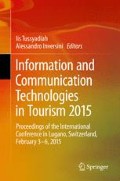Abstract
Social networking sites (SNSs) have become important and popular tools for not only presenting self-image, but also sharing travel information. This study adopted self-image expressions to understand tourists’ intentions to share travel information and behavioural changes in SNSs. To enhance understanding tourists’ intention and behaviour, the current study suggests a research model based on motivations for self-image expression (i.e., creativity, altruism and social relationship). This current study empirically resulted in the importance of users’ creativity, altruism and social relationship in SNSs, which leads to the intention and behavioural changes to share travel information. In addition, altruism moderated the negative effect of creativity on self-image expression as well as the positive effect of social relationship on self-image expression. Based on the result of this study, the current study bears some implications in theoretical and practical context.
Access this chapter
Tax calculation will be finalised at checkout
Purchases are for personal use only
References
Ahuja, M. K., & Thatcher, J. B. (2005). Moving beyond intentions and toward the theory of trying: Effects of work environments and gender on post-adoption information technology use. MIS Quarterly, 29(3), 427–459.
Ashforth, B. E., & Mael, F. (1989). Social identity theory and the organization. Academy of Management Review, 14(1), 20–39.
Bagozzi, R. P., & Yi, Y. (1988). On the evaluation of structural equation models. Journal of the Academy of Marketing Science, 16(1), 74–94.
Batson, C. D., & Powell, A. A. (2003). Altruism and prosocial behavior. Handbook of Social Psychology, 2, 282.
Baumeister, R. F. (1998). The self. In D. T. Gilbert, S. T. Fiske, & G. Lindzey (Eds.), Handbook of social psychology (4th ed., pp. 680–740). New York: McGraw-Hill.
Chin, W. W. (1998). The partial least squares approach to structural equation modeling. In G. A. Marcoulides (Ed.), Modern methods for business research (pp. 298–336). Mahwah, NJ: Erlbaum.
Fishbein, M., & Ajzen, I. (1975). Belief, attitude, intention and behavior: An introduction to theory and research. Boston: Addison-Wesley.
Fornell, C., & Larcker, D. F. (1981). Evaluating structural equation models with unobservable variables and measurement error. Journal of Marketing Research, 18(1), 39–50.
Frazier, P. A., Tix, A. P., & Barron, K. E. (2004). Testing moderator and mediator effects in counseling psychology research. Journal of Counseling Psychology, 51(1), 115.
Ha, S., & Ahn, J. (2011). Why are you sharing others’ tweets? The impact of argument quality and source credibility on information sharing behavior. ICIS 2011 Proceedings, 1–11.
Kim, J., & Lee, J. R. (2011). The Facebook paths to happiness: Effects of the number of Facebook friends and self-presentation on subjective well-being. Cyberpsychology, Behavior and Social Networking, 14(6), 359–364.
Kim, J., & Tussyadiah, I. P. (2013). Social networking and social support in tourism experience: The moderating role of online self-presentation strategies. Journal of Travel & Tourism Marketing, 30(1–2), 78–92.
Kim, H. W., Gupta, S., & Koh, J. (2011a). Investigating the intention to purchase digital items in social networking communities: A customer value perspective. Information and Management, 48(6), 228–234.
Kim, H. W., Zheng, J. R., & Gupta, S. (2011b). Examining knowledge contribution from the perspective of an online identity in blogging communities. Computers in Human Behavior, 27(5), 1152–1161.
Kim, H. W., Chan, H. C., & Kankanhalli, A. (2012). What motivates people to purchase digital items on virtual community websites? The desire for online self-presentation. Information Systems Research, 23(4), 1232–1245.
Leary, M. R. (1995). Self-presentation: Impression management and interpersonal behavior. Madison: Brown & Benchmark.
Lee, G., & Lee, W. J. (2010). Altruistic traits and organizational conditions in helping online. Computers in Human Behavior, 26(6), 1574–1580.
McKenna, K. Y., Green, A. S., & Gleason, M. E. (2002). Relationship formation on the Internet: What’s the big attraction? Journal of Social Issues, 58(1), 9–31.
Ong, E. Y., Ang, R. P., Ho, J., Lim, J. C., Goh, D. H., Lee, C. S., et al. (2011). Narcissism, extraversion and adolescents’ self-presentation on Facebook. Personality and Individual Differences, 50(2), 180–185.
Parra-López, E., Bulchand-Gidumal, J., Gutiérrez-Taño, D., & Díaz-Armas, R. (2011). Intentions to use social media in organizing and taking vacation trips. Computers in Human Behavior, 27(2), 640–654.
Qu, H., & Lee, H. (2011). Travelers’ social identification and membership behaviors in online travel community. Tourism Management, 32(6), 1262–1270.
Turner, J. C., Hogg, M. A., Oakes, P. J., Reicher, S. D., & Wetherell, M. S. (1987). Rediscovering the social group: A self-categorization theory. Oxford, England: Basil Blackwell.
Walther, J. B. (2007). Selective self-presentation in computer-mediated communication: Hyperpersonal dimensions of technology, language, and cognition. Computers in Human Behavior, 23(5), 2538–2557.
Wang, Y., & Fesenmaier, D. R. (2004). Towards understanding members’ general participation in and active contribution to an online travel community. Tourism Management, 25(6), 709–722.
Wasko, M. M., & Faraj, S. (2005). Why should I share? Examining social capital and knowledge contribution in electronic networks of practice. MIS Quarterly, 29(1), 35–57.
Xiang, Z., & Gretzel, U. (2010). Role of social media in online travel information search. Tourism Management, 31(2), 179–188.
Acknowledgements
This work was supported by the National Research Foundation of Korea Grant funded by the Korean Government (NRF-2013S1A3A2043345).
Author information
Authors and Affiliations
Corresponding author
Editor information
Editors and Affiliations
Rights and permissions
Copyright information
© 2015 Springer International Publishing Switzerland
About this paper
Cite this paper
Koo, C., Joun, Y., Han, H., Chung, N. (2015). Mediating Roles of Self-image Expression: Sharing Travel Information of SNSs. In: Tussyadiah, I., Inversini, A. (eds) Information and Communication Technologies in Tourism 2015. Springer, Cham. https://doi.org/10.1007/978-3-319-14343-9_17
Download citation
DOI: https://doi.org/10.1007/978-3-319-14343-9_17
Published:
Publisher Name: Springer, Cham
Print ISBN: 978-3-319-14342-2
Online ISBN: 978-3-319-14343-9
eBook Packages: Business and EconomicsBusiness and Management (R0)

